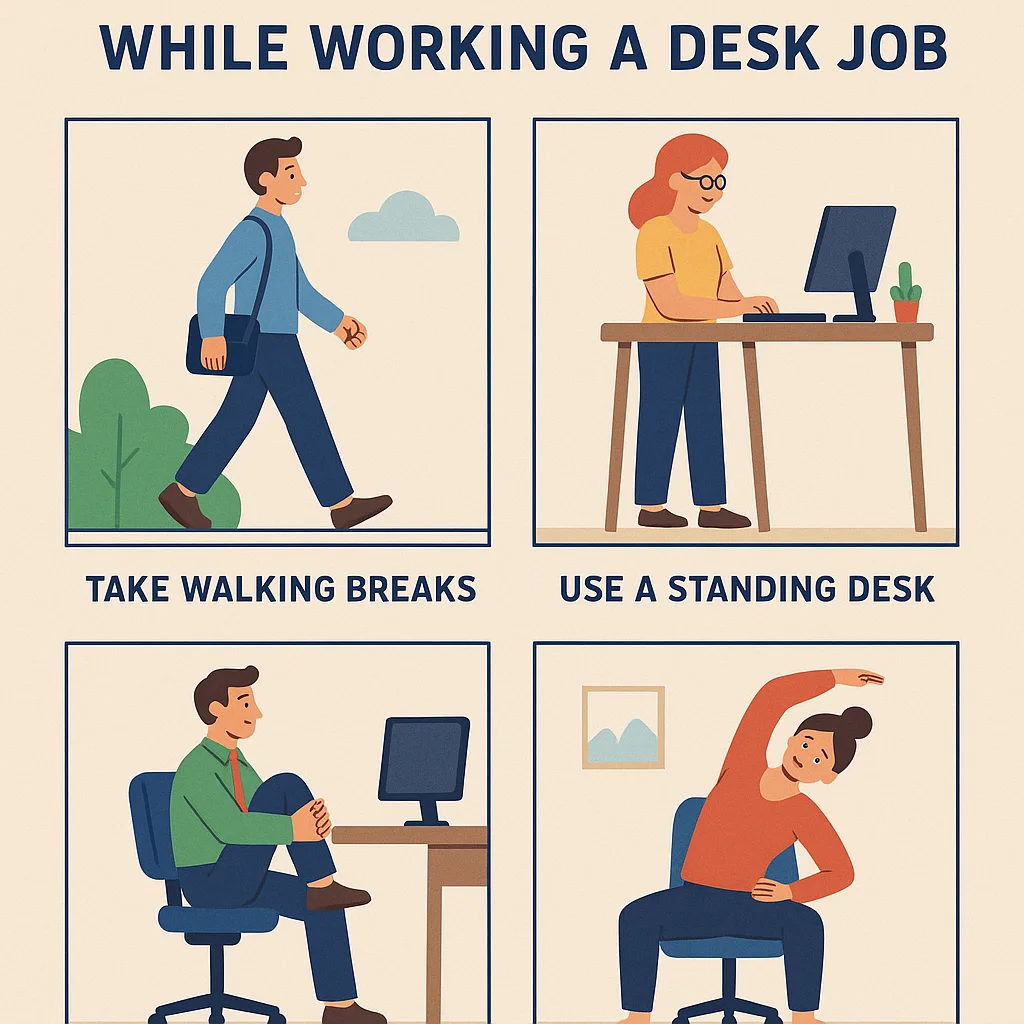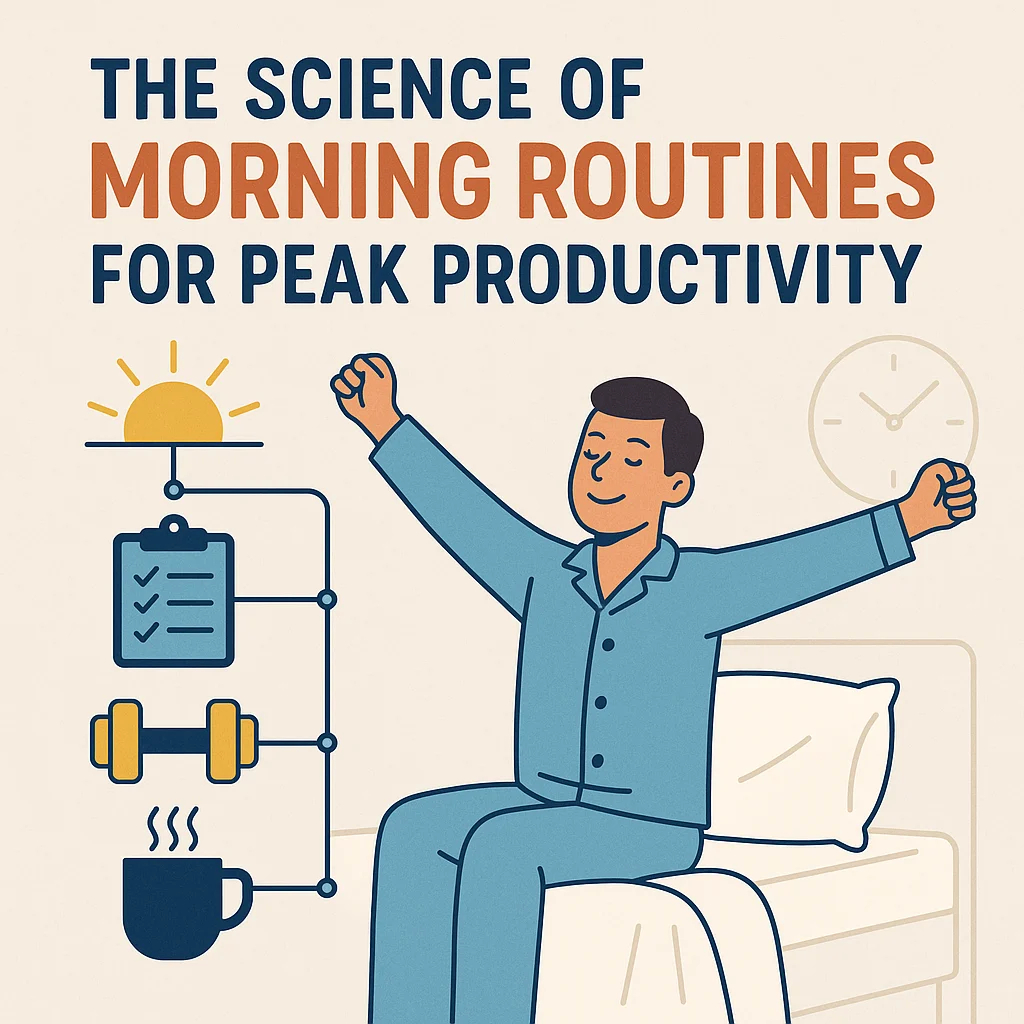Millions of people spend the majority of their days in front of screens in today's modern workplace. Sedentary behavior is a silent but dangerous lifestyle risk that has been brought about by the shift to desk-based jobs, despite the fact that it has increased efficiency and created opportunities for remote work. Long periods of sitting can raise your risk of developing diabetes, heart disease, obesity, bad posture, and mental exhaustion.
The good news is that you can maintain your health without quitting your job or spending two hours a day at the gym. Even if you work a desk job from 9 to 5, you can maintain your fitness with the correct routines and techniques. The greatest scientifically supported advice for enhancing your physical and mental health while working at a desk will be covered in this guide.
The Hidden Health Risks of Sitting Too Much
Before diving into solutions, it’s important to understand what’s at stake. Long periods of sitting have been linked to:
-
Cardiovascular disease
-
Lower back and neck pain
-
Muscle imbalances
-
Obesity
-
Insulin resistance
-
Varicose veins
-
Mental fatigue and poor focus
According to studies, unless exercise is combined with movement throughout the day, it may not be enough to completely reverse the detrimental effects of prolonged sitting.
Key Strategies to Stay Fit at a Desk Job
Let’s break down the most practical, sustainable ways to keep your body active and your mind fresh during work hours.
1. 🕒 Break Up Sitting Time with the 30:5 Rule
The science: Sitting for hours without a break can reduce blood flow, compress muscles, and lead to fatigue.
The fix: Follow the 30:5 rule, which states that you should get up and move for at least five minutes every thirty minutes. This increases energy, burns calories, and improves circulation.
Tips:
-
Set reminders or use apps like Stand Up! or Stretchly
-
Use breaks to refill water, do squats, or take a walk
2. 🪑 Invest in an Ergonomic Workspace
Poor posture leads to chronic back and neck pain, tension headaches, and even reduced lung capacity.
Essentials for a healthy workstation:
-
Adjustable chair with lumbar support
-
Desk at elbow height
-
Monitor at eye level (or use a laptop stand)
-
Keyboard and mouse at wrist height
-
Footrest if your feet don’t touch the ground
Ergonomics isn’t just about comfort—it reduces strain on muscles and improves focus.
3. 🧍♂️ Use a Standing Desk (or DIY Version)
Switching between standing and sitting helps reduce sedentary time and engage various muscle groups.
Benefits of a standing desk:
-
Burns more calories than sitting
-
Reduces back and shoulder pain
-
Increases energy and alertness
Use books or boxes to elevate your monitor for brief periods of time if you don't have a standing desk. To begin, try the Pomodoro technique, which involves 25 minutes of sitting and 5 minutes of standing.
4. 🏃♀️ Walk Whenever Possible
The effects of sitting can be reversed by taking even brief walks. Walking 10,000 steps a day lowers cholesterol and improves cardiovascular health, according to the American Heart Association.
Ways to walk more:
-
Pace while on calls
-
Take a walk after lunch
-
Walk to a farther bathroom or water cooler
-
Park further away from your office entrance
Even 3–5 short walks a day (5–10 minutes each) make a significant difference.
5. 💪 Do Desk Exercises and Stretches
To build muscle, you don't need a gym. Throughout the day, incorporate stretches and micro-exercises.
Examples:
-
Seated leg raises
-
Wall sits
-
Desk push-ups
-
Calf raises while brushing your teeth
-
Shoulder rolls and neck stretches
Stretching reduces stiffness and improves circulation. Aim to stretch your neck, back, hips, and hamstrings daily.
6. 🧘♀️ Incorporate Mindful Movement
Fitness isn’t just physical—it’s also about staying mentally refreshed.
Mindful movement options:
-
5-minute breathing exercises
-
Chair yoga stretches
-
Tai Chi or mobility routines during breaks
Mindfulness reduces stress and improves productivity. Apps like Insight Timer or Calm can guide you.
7. 🥗 Eat Smart, Not Just Less
Your health goals may be derailed by poor eating habits at work, such as skipping meals, consuming junk food, or consuming excessive amounts of caffeine.
Tips for eating clean at work:
-
Meal prep to avoid unhealthy takeout
-
Keep healthy snacks like almonds, fruit, or Greek yogurt
-
Stay hydrated—dehydration can mimic hunger
For long-lasting energy without crashes, try to eat balanced meals that include fiber, protein, and healthy fats.
8. 💧 Stay Hydrated Throughout the Day
Proper hydration:
-
Improves brain function
-
Reduces fatigue
-
Prevents overeating
Best practices:
-
Keep a large water bottle at your desk
-
Flavor with lemon, cucumber, or mint
-
Set a water-drinking timer every hour
Depending on your body weight and level of activity, consuming two to three liters of water each day is a good goal.
9. 💤 Prioritize Quality Sleep
Sleep and fitness go hand-in-hand. Sleep deprivation:
-
Increases cortisol (stress hormone)
-
Decreases metabolism
-
Impacts motivation and recovery
Sleep hygiene tips:
-
Avoid screens 1 hour before bed
-
Keep a consistent sleep-wake cycle
-
Limit caffeine after 2 PM
For the best possible physical and mental performance, most adults require 7 to 9 hours of sleep per night.
10. 🎯 Track Progress and Set Realistic Goals
Fitness is about consistency, not perfection.
Tools to track:
-
Pedometers or fitness trackers (like Fitbit or Apple Watch)
-
Habit tracking apps (like Streaks or Habitica)
-
Workout logs and nutrition journals
Set small, attainable goals:
-
“Stretch twice during work hours”
-
“Take 5,000 steps by lunch”
-
“Stand for 1 hour total each day”
The key is building momentum and adjusting as needed.
Sample Daily Routine for Desk Workers
| Time | Activity |
|---|---|
| 7:00 AM | Wake up, stretch, 10-min walk |
| 8:00 AM | Healthy breakfast, hydrate |
| 9:00 AM | Begin work (ergonomic desk setup) |
| 9:30 AM | 5-min stand and stretch |
| 10:30 AM | Walk while on call |
| 12:30 PM | Lunch + 15-minute walk |
| 2:00 PM | 3-min desk exercises |
| 3:30 PM | 5-min breathing/stretch break |
| 5:30 PM | End work + short workout or yoga |
| 9:30 PM | Screen-free wind down, prep for sleep |
This is just a guide—you can adapt it to your lifestyle and energy levels.
Staying Fit Is About Intentional Living
Your health doesn't have to suffer because of desk work. You can improve your energy, protect your body, and sharpen your mind with awareness, a few tweaks, and persistent effort.
Key takeaways:
-
Break sitting time every 30 minutes
-
Move more throughout the day
-
Eat and sleep well
-
Be intentional with your posture, energy, and habits
In the end, fitness is about scheduling time for your health, even in little bursts throughout the day, rather than about having more time. Your longevity, happiness, and productivity will all benefit from your body's gratitude.




Leave a Reply